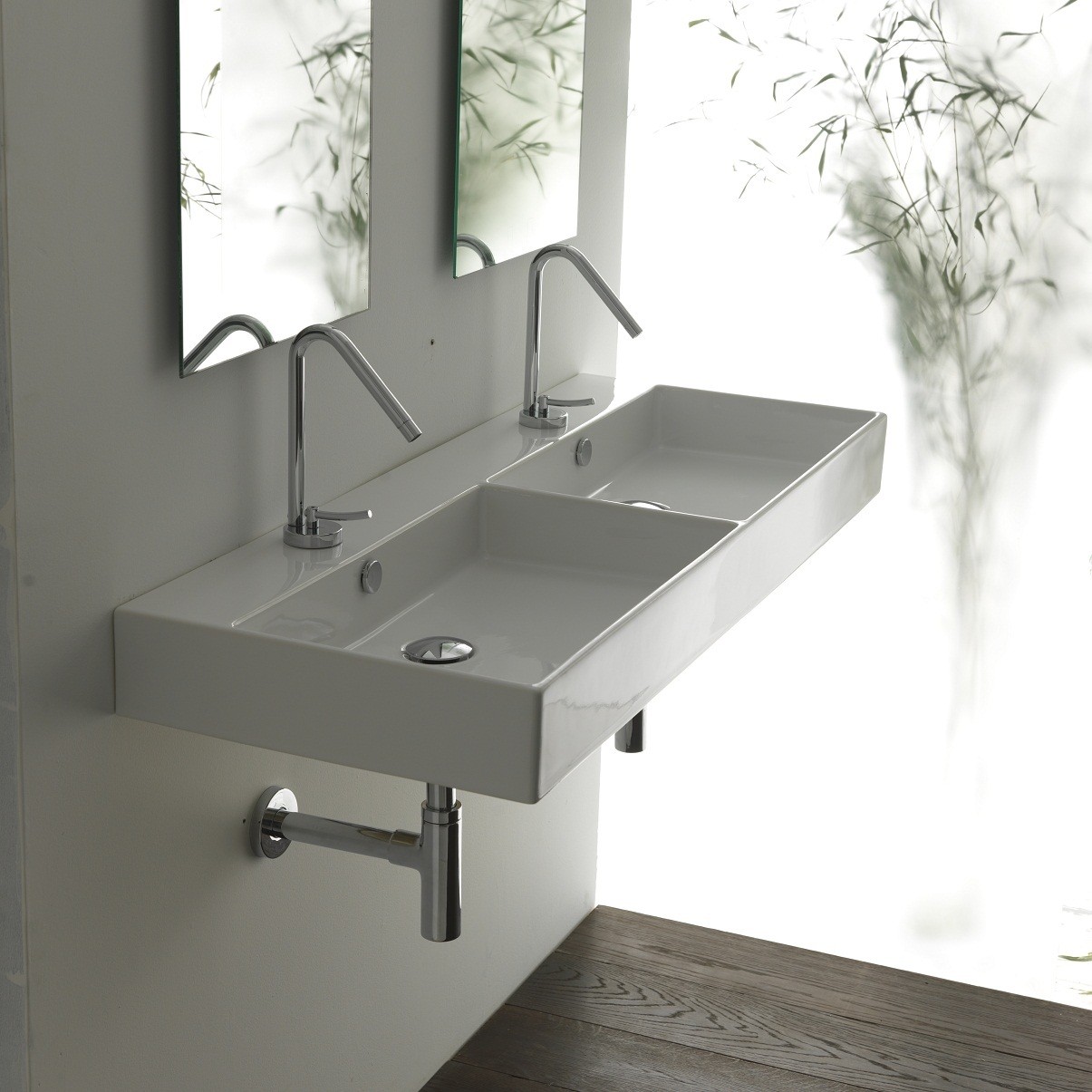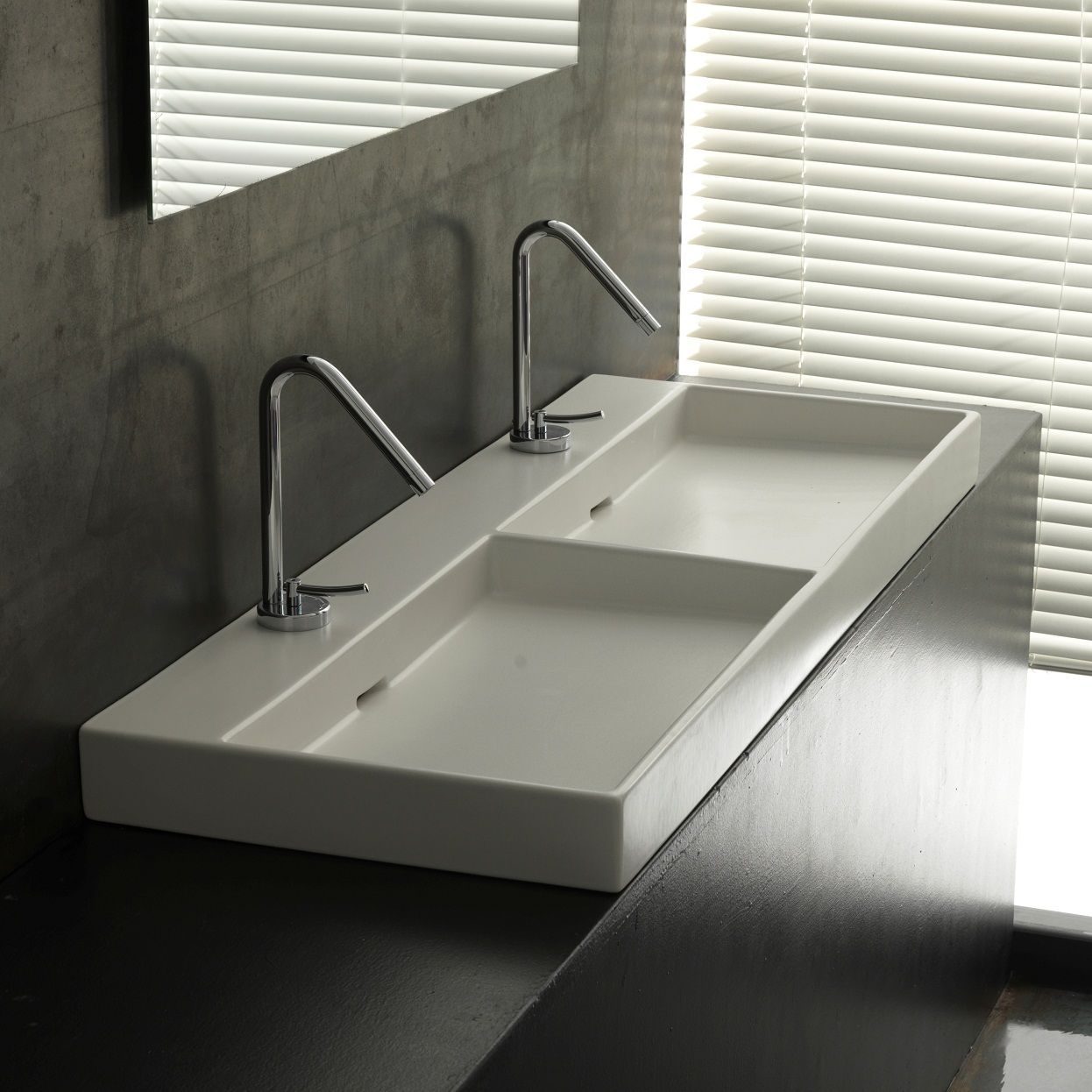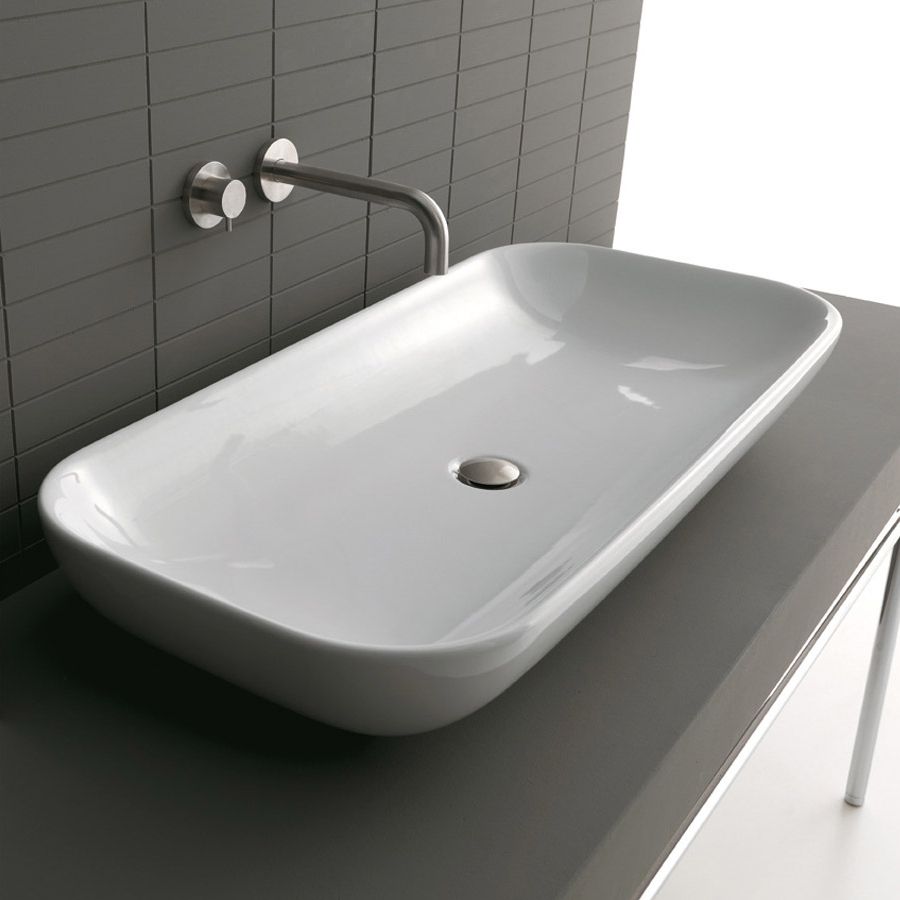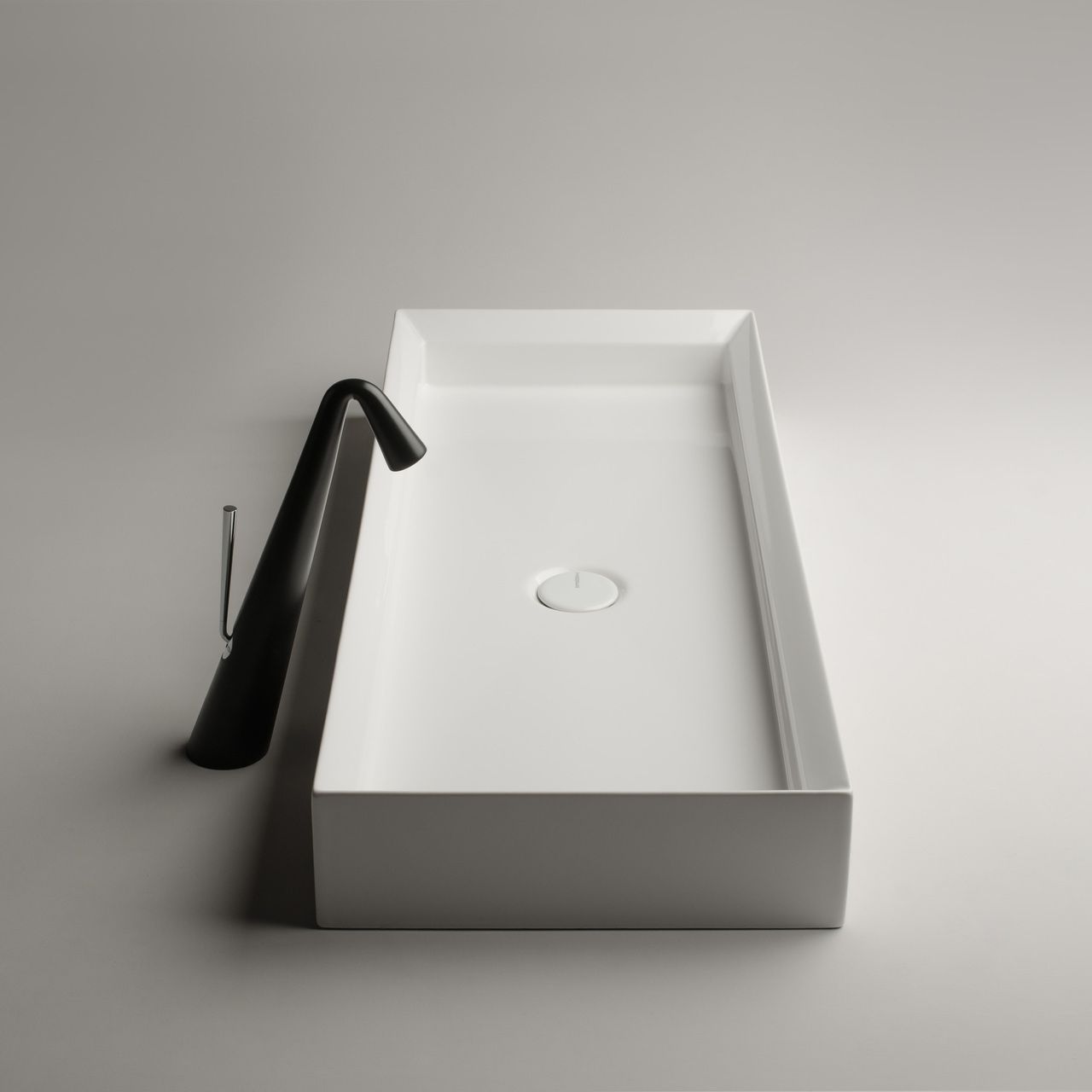Standard Bathroom Sink Size
The size of the bathroom sink you choose for your project can be a very important aspect in the utility and design of your bathroom. Whether you are renovating a small bathroom with a pedestal sink or designing a large public bathroom, determining the correct bathroom sink sizes will be crucial to the outcome of the project. This article outlines the different types of bathroom sinks and common sink sizes for different applications, materials, and projects.
Standard Sink Sizes
What is considered a standard size bathroom sink? The answer typically depends on the application. In addition, the size of the bathroom and the number of people that will be using the bathroom sink. A bathroom sink can range in size from as small as 10" up to much larger sizes up to 70 ot 80" (though sinks that big are not very common). The most common size for a bathroom sink is in the 20" to 30" range. However, in the following sections, we outline the different sizes ranging from tiny to medium to large bathroom sinks and look further into double bathroom sinks and trough sinks.
Tiny Bathroom Sinks (under 15")
Tiny bathroom sinks, typically under 15" in length, are perfect for small bathroom designs where space is very limited. Due to their size, it is very common that tiny bathroom sinks are wall mounted or attached to a narrow bathroom vanity. They can be very appealing in design. However, their use is very limited due to their size.
Small Bathroom Sinks (15" to 20")
Small bathroom sinks, much like tiny bathroom sinks are great for bathrooms limited on space. These sinks can be vessel sinks or undermount sinks as well as wall mounted. This sink size is great for a guest bathroom or a single vanity sink. Small sinks are recommended for any small to medium sized bathroom.
Medium Bathroom Sinks (20" to 30")
A medium bathroom sink will work in any sized bathroom except extremely small bathroom designs. As long as you have the vanity, counter space or wall space, a medium sized bathroom sink can be used in a variety of different sink styles. An example of a medium sized sink would be a typical undermount bathroom sink in a master bath. This encompasses most standard sink sizes for residential bathroom projects. It is also the most common size for public restrooms, restaurant bathrooms and office/ commercial space bathrooms.
Large Bathroom Sinks (30" to 40")
Large bathroom sinks, typically ranging from 30" to 40" in size, require a fairly large bathroom design for a comfortable installation. These sinks will sometimes be difficult to fit on a vanity due to the larger size. These sinks will work wonderfully as wall mounted sinks, double bathroom sinks and trough sinks. It is important to make sure you have enough space on each side of the sink when you do this.
Very Large Bathroom Sinks (40" to 50")
Very large bathroom sinks will almost always come in the form of a double bathroom sink or a trough bathroom sink. Measuring 40" to 50", they are great for the incorporation of multiple faucets, and can be used by two people at one time. They work best when mounted on the wall.
Double Bathroom Sinks


Double bathroom sinks have two basins. This allows multiple people to use the bathroom sink at once. You can also incorporate two separate sinks. It is important to first have a large enough countertop to fit the sink or sinks. A typical size for a double bathroom sink is around 47". If you have two separate sinks, you should have at least 12 inches between the sinks. This will provide each person with sufficient space for a comfortable area.
Trough Bathroom Sinks


Trough bathroom sinks are large bathroom sinks with one large basin. They can accommodate two or more people. Depending on the size. This bathroom sink can be mounted with or without a vanity. A trough sink can have a variety of bathroom sink depths, depending on style and design of the sink. It has a large basin, making this bathroom sink quite versatile. The typical size of a trough bathroom sink is around 40".
Undermount Bathroom Sinks
Undermount bathroom sinks are common types of bathroom sinks. These bathroom sinks are typically under 20" in order to give you enough space to do a number of tasks while not being overly large. Undermount bathroom sinks can be installed as a pair as well, given that there is enough space on the vanity or countertop. There should be at least 12" in between the sinks in order to give each person enough space to use each one.
Large trough undermount bathroom sinks are great for larger bathrooms. It is a great way to incorporate a large basin with one or more faucets. They function in the exact same way as other undermount sinks, they just have more space in the actual basin. A trough undermount bathroom sink will also add a great unique element of design in your bathroom design as well.
Vessel Sink Sizes
Vessel bathroom sinks are bathroom sinks that sit beautifully on top of a vanity or countertop. When it comes to the size, a vessel bathroom sink will typically measure between 15" and 25" though larger vessel sinks are becoming more popular. Depending on whether the sink is round or rectangular, the dimensions could vary. A round vessel sink will usually be 16" to 20" in diameter and a rectangular vessel sink will usually be 20" or greater. The depth of a vessel sink can vary depending on the design, but the typical depth (height) of a vessel bathroom sink will be around 4" to 8". Modern bathroom sinks are usually sleeker and are closer to the 4" to 5" depths. Moreover, wider vessel bathroom sinks will usually have a slightly less depth to preserve its design.
Vessel bathroom sinks are generally used in more stylish bathroom designs. They can be used in both residential and commercial bathrooms. Ceramic vessel bathroom sinks will work well in commercial bathrooms due to the durable build quality and easy maintenance. You have a bit more freedom in residential projects due to the reduced amount of people using the sink in general. Public sink sizes will typically be a bit larger.
Wall Mount Sink Sizes
Wall mounted bathroom sinks are beautiful pieces of bathroom furniture that are mounted squarely on a wall in your bathroom. Because these bathroom sinks essentially replace your bathroom vanity, they can be larger than other bathroom sink styles. The typical width (front to back) of a wall mount bathroom sink is 15 to 18", but they can be larger depending on the situation. The depth of a wall mount bathroom sink is about 5" to 8". Of course, depending on the size of your bathroom and what you plan on using the sink for, the dimensions could be much smaller or larger.
The plumbing of the wall mount bathroom sink is exposed underneath, giving you the option to display a beautiful set of plumbing hardware. In addition, these sinks can incorporate large basins. Wall mount bathroom sinks vary in both size and style. Public sink sizes and residential sink sizes will be different, so it is important to use an appropriate size for each location.
Pedestal Sink Sizes
A pedestal bathroom sink is a basin placed beautifully on a pedestal stand, creating a unique fixture for any bathroom design. The most common size for a pedestal bathroom sink is between 22" to 28". A pedestal bathroom sink will almost always be within this size range with a few exceptions. The width of these sinks will typically be 17" to 20" depending on the shape and style.
Because these sinks are on a pedestal, you will be able to fit them in smaller spaces. However, you will still be able to use a fairly large basin. Similar to a wall mount sink, a pedestal bathroom sink will be great for opening up the bathroom a bit and creating some space. These sinks work extremely well in vintage or classic bathroom designs due to their old fashioned and beautiful design.
Drop-In Sink Sizes
Drop-in bathroom sinks are very easy to install and work beautifully on a matching vanity or countertop. Drop-in sinks are installed differently than undermount bathroom sinks, but they are typically the same general size. The size of a drop-in bathroom sink will be 16" to 24" in length while being about 12" to 20" from front to back. The lip on the edge of the sink is used to support the weight of the sink while also adding to the overall size. These sinks will be slightly larger than an undermount sink because of this.
A drop-in bathroom sink is a beautiful sink due to the versatility of the design. These sinks are common for several bathroom styles because they are easy to install as well. Consider two drop-in sinks on a double vanity for a beautiful pair of bathroom sinks. Install the sinks with at least 12" of space in between them for comfortable access and ample space for each person using them.
Semi-Recessed Sink Sizes
A semi-recessed sink can be seen as somewhat of a combination of a vessel sink and a drop-in sink in terms of how it is installed. The size of a semi-recessed bathroom sink is 16" to 24", but can vary depending on the size of the vanity or sink. The width of a semi-recessed bathroom sink is similar to other sinks on this list, being around 12" to 20".
This type of sink is a great bathroom sink for both commercial and residential use. If you plan on using this in a home bathroom, consider a beautiful ceramic or cast iron material. In a commercial project, use similar durable materials due to the amount of people that will be using the sink. A semi-recessed bathroom sink is always a good option for a bathroom vanity or countertop.
Corner Sink Sizes
A corner bathroom sink is one of the smaller sinks on the list. The size of a corner sink will depend on whether or not it is being used with a vanity or not. If the corner bathroom sink is being mounted directly onto the wall, it will be 17" to 24". If the corner sink is being used on a vanity, it can be a little smaller at about 16" to 20". The size of the sink will vary depending on the size of the cabinet and how much space you have to work with in the corner you plan on installing the sink.
A corner sink is perfect for saving space in a small bathroom or powder room. These sinks are also very affordable due to their smaller sizes. Even if you have a larger bathroom design, a corner sink can be a great way to incorporate an additional sink. Consider a corner bathroom sink for your next bathroom renovation.
How To Measure a Bathroom Sink
Measuring a bathroom sink requires you to measure several components of the sink. First, you should measure the width, length and depth of the actual basin of the bathroom sink. Make sure you are only measuring the basin of the sink and not the bathroom sink as a whole. Measure the length, width and depth of the body of the sink. This can include a pedestal, space between faucet holes or other features.
You also need to measure the space on the countertop, if any. Measure your vanity in order to find out how much space you will have to house a bathroom sink as well. Your sink should be mounted at about 34" from the ground if wall mounted. Use a measuring tape for all of these measurements.
How to Choose Bathroom a Bathroom Sink Size
What Do You Need?
First of all, you need to decide what size sink you need in your specific bathroom design. A good place to start is by putting your wants and needs first. Consider what you will be using the sink for. Of course, you will need to wash your hands, brush your teeth and other similar tasks. If you need a large amount of space for these things, consider a large sink with a deep basin. On the other hand, if you are only using your sink for small, quick things, you may only require a smaller sink. The height of the bathroom sink should be comfortable for you as well. If you are fine with the average height of 34", go with that. If you are shorter or taller, you may want to adjust that height in order to accommodate you and give you a comfortable and accessible bathroom sink.
Additional Necessities
Once you know what kind of sink you need, you need to know where you can put it. This will depend on the size of your bathroom as well as the other fixtures in it. If you are working with a small bathroom or a powder room, you will need a tiny bathroom sink or a small bathroom sink. A large master bathroom will allow for the incorporation of a larger bathroom sink or multiple bathroom sinks. If there are multiple people using the bathroom, this is something you should consider. If you are purchasing a commercial sink, make sure the sink is both big and deep enough for guests to comfortably use.
Bathroom Vanity Sizes
The bathroom sink of your choice will need an appropriately sized vanity. A single sink will typically be housed in/on a bathroom vanity measuring from 24" to 48". This size range will fit almost every type of bathroom sink. If you are going by the size ranges in this guide, a vanity in this range will fit everything from a tiny bathroom sink to certain large bathroom sinks. Depending on the size of your bathroom, the size of the vanity will be different, just like a bathroom sink. Smaller bathrooms may not have room for a vanity, so don't try to force one into a design that it won't fit in.
If you plan on incorporating a double bathroom sink or two side by side sinks, you will need a vanity that measures at least 60" in length. The perfect size would ideally fit within the 60" 72" range. This size is perfect for fitting exactly two sinks with a 12" gap in between the two. As far as depth goes, it depends what kind of sinks you plan on using. The average depth of a vanity will be 20" to 24", but this may vary depending on the type of vanity as well as the sink you use.
How Much Space do you Have?
When choosing a bathroom sink, it is important to allocate the proper amount of space for. First, if you are using a vanity, you need to take counter space into consideration. On each side of the sink, you should have at least 4" on each side of the sink. This will give you necessary counter space for other items and comfortable use. You can go more than 4" if you want more counter space. You also need this space for the installation of the sink. For example, an undermount sink will need a few inches on each side for a proper and secure installation.
You should also know how much space you have for your wall mounted or pedestal sink. For wall mounted sinks, you should mount it at about 34" from the ground. Make sure there is nothing in the way of where you want your wall mounted sink to be mounted. For a pedestal sink, it depends on the height of the pedestal. Pedestal sinks are similar to wall mounted sinks in terms of height. 32" to 34" inches are common for pedestal sink with some slight variations. On each side of the sink, you should have enough space for some wall mounted accessories or counter space on each side of the basin.
Faucet Sizes and Types
The type of faucet you use will be dependent on what your sink will allow. If you are using a tiny bathroom sink, you might find a single faucet hole on either side of the basin. You also might benefit from a wall mounted faucet to maximize space. A very large sink will most likely be able to accommodate any type of faucet, depending on the design. Many larger sinks will have one to three faucet holes that will be able to incorporate any type of faucet. Many bathroom sinks will incorporate one to three faucet holes. Tiny or small bathroom sinks usually have just one or none at all.
You should also consider the size and depth of the sink basin. A faucet needs to be at a height that will minimize the amount of splashing when it hits the bottom of the sink basin. If the depth of your sink is very shallow, don't mount your faucet too high or else water will likely splash outside of the sink. Aim to have the spout of your faucet about 6" above the bottom of the basin of your sink. This height may vary slightly depending on the type of sink and faucet you are using.
Frequently Asked Questions About Bathroom Sink Sizes
Q: How Do I Choose the Right Bathroom Sink Size?
A: The size of your bathroom sink will depend on where the sink will be located, if it will be on/in a vanity and the overall size of your bathroom. If you have a large bathroom, you will have more flexibility when it comes to the size of your bathroom sink. A small bathroom design will require a smaller bathroom sink in order to create as much space as possible. In this case, consider a wall mounted corner sink.
Q: What Faucets Can I Use?
A: The faucet you use will depend on the type of sink you have, so not every faucet will work. The number of faucet holes, if any, will determine which faucet you will be able to use. If the sink does not have room for a faucet, you will need to use a wall mounted faucet. Choose a sink that has the appropriate number of faucet holes or counter space so that you can use your preferred faucet type.
Q: What is the Standard Bathroom Sink Size?
A: A common question when it comes to sink replacement is, "Is there an average bathroom sink size?" The short answer is that there is no standard size for a bathroom sink. This is because each bathroom sink style is different in terms of both design and installation type. The average size for a single vanity bathroom sink will be around 14" to 20", but the range will vary. Depending on what you are using the sink for, there are several different sizes to go with.
Q: How Do I Measure a Bathroom Sink?
A: To measure a bathroom sink, you need to measure both the basin of the sink as well as the sink as a whole. This will give you all of the information you need in terms of the sink's dimensions. Measure the length and width of the entire sink. Then measure the length, width and depth of the basin. Measure the height of the sink as well depending on the type of sink you have. You should also measure the space you have on your countertop to ensure that you can accommodate the sink of your choice.
Q: How Do I Measure an Undermount Bathroom Sink?
A: An undermount bathroom sink needs to be measured a bit differently than other bathroom sinks. First, measure the depth of the bathroom sink to see how much space you need for the sink under the counter. You should also measure the full dimensions of the sink to know the exact size of the hole required for the countertop or vanity. You should leave at least 4" of counter space on each side of the sink.
Q: How Many People Are Using the Sink?
A: If more than one person is going to use the sink, consider a trough bathroom sink or a double bathroom sink. This will ensure that each person will have a comfortable amount of space. If only one person will be using the sink, a single basin sink will work just fine. As long as the bathroom sink capacity is enough for your situation, everything should run smoothly for you.
Q: Does the Shape of the Sink Matter?
A: Sometimes the shape of the sink will matter depending on where it needs to be placed. A corner bathroom sink needs to fit squarely in the corner of your bathroom, so the shape definitely matters in this case. On the other hand, a vessel bathroom sink can be a variety of shapes. As long as it fits on the vanity or countertop. There are no bathroom sink standard dimensions when it comes to different shaped bathroom sinks.
Source: https://www.modobath.com/inspiration/bathroom-sink-size-guide/


0 Komentar